Link para o artigo original: https://colchesterglobal.com/united-states/wp-content/uploads/The-Case-for-Local-Currency-Emerging-Market-Debt-July-2023.pdf
Local Currency Emerging Market (“EM”) government debt has been through a number of distinct cycles since the early 2000’s when these markets became more liquid, widely traded, and began to be seen as viable investment destinations(1). Like all bond markets, their returns have ebbed and flowed as a function of their inflation outlook, the macroeconomic backdrop, policy framework, and the strength and weakness of their currencies. After facing a number of headwinds in the recent past, we believe that the asset class is now well placed to benefit from a sustained upswing. Specifically, further US dollar weakness, relatively high and attractive real yields, sound macroeconomic management, and declining inflation across the major economies within the local currency asset class all suggest that this asset class is about to undergo a sustained period of strong performance – notwithstanding the gains made to date since their recent low in the fourth quarter of 2022. Likely further declines in the US dollar, together with their stronger balance sheets and less reliance on US hard currency funding, also suggest that EM local currency debt is likely to outperform EM Hard Currency debt in the coming period.
Balance Sheet Strength
Notwithstanding the Covid-19 shock, subsequent supply chain disruption, the invasion of the Ukraine, and swings in commodity prices, the resilience of EM local currency debt over the past three years has been a testament to the improvements in economic management and the credibility gains made in many of these economies. Clearly, this is not the case for all “Emerging Markets”, and economies such as Lebanon, Sri Lanka and Argentina have all experienced significant financial distress in recent years. Not only do these latter economies suffer from poor governance, weak policy making and high inflation, they are also typically dependent upon foreign capital. Such hard currency funding typically results in them being included in most EM hard currency benchmarks, but not the higher quality local benchmarks. Colchester believes that these countries are better considered as “Frontier Markets”, with similar characteristics to the emerging markets of yesteryear. In the absence of a robust monetary policy framework, inflation can also take hold in more advanced emerging markets with adverse consequences. Türkiye would be a prime example of that in the recent past. Notwithstanding the odd exception, the stronger economies in this space have left the erratic policy making of the 1980’s and 90’s behind. Despite an array of challenges and shocks that have buffered the global economy over the past three years or so, the absence of systemic crises across the entire EM universe highlights the relative stability and resilience of the major economies such as Brazil, Mexico, Poland, Indonesia, and others.
This resilience can be seen in the government debt to GDP ratio, the ratio of debt service costs to revenues, and the level of inflation in the local currency EM opportunity set. Charts 1 and 2 present these metrics, on a weighted average basis for the countries comprising the JP Morgan GBI-EM Global Diversified index. Whilst debt levels did rise in response to the Covid-19 pandemic – as they did elsewhere – average EM government debt levels of around 56% of GDP in 2023 are remarkedly only half that of Advanced Economies(2). While interest costs were low through 2020 and 2021, they rose in 2022 in line with the generalized increase in yields globally. In our opinion, interest costs of less than 12% of revenues are not a cause for significant concern, nor necessarily a signal of enhanced risk levels. Recent examples of debt distress have been in countries where this ratio has been dramatically higher. For example, the ratio was over 70% in Sri Lanka in 2021, and it was close to 45% in Ghana in 2022 when both these frontier markets ran into difficulty.
As shown in Chart 2, inflation in the major Emerging Markets declined in the two decades preceding the pandemic, a result of more credible policymaking, improved governance, and enhanced macroeconomic stability. Inflation, in almost all economies spiked in 2022, but importantly the experience of the major Emerging Markets was not dissimilar to that of Developed Markets (“DM”). Whilst compositional differences in the measurement of the CPI (e.g. EM countries tend to have a higher weight of food and other essentials in their CPI basket, compared with DM) led to higher headline inflation in some, but not all, EM countries. It is noteworthy that inflation in the likes of Brazil and Indonesia today is lower than in Germany(3). Similarly, Mexico and South Africa experienced lower inflation than the UK over the same period.
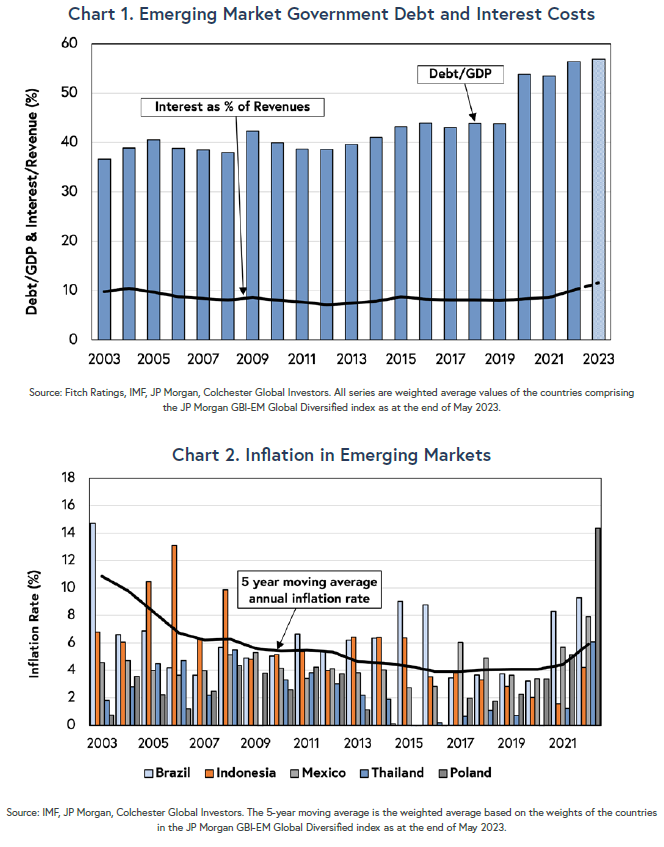
![]()
Comparing Local and Hard Currency Emerging Market Debt
Whilst the two asset classes carry the same name, “emerging market”, the characteristics and credit quality of both are different. Stronger balance sheets, flexible exchange rate regimes, better governance and sustained credible policy making are typically associated with higher credit ratings. Economies with stronger credit ratings typically fund themselves domestically in local currency, rather than in hard currency (e.g. via the issuance of US dollar denominated debt(4)). This has the advantage of tapping into a stable domestic savings base, eliminating currency risk, and, more often than not, can be obtained at a lower cost. It also reduces dependency on sometimes fickle foreign capital flows. In contrast, weaker economies often have little choice but to issue in hard currency. This has resulted in a scenario where the underlying financial stability and creditworthiness differs between the local and hard currency EM government debt opportunity set. The net result is a lower average credit rating on the hard currency EM bond index compared with its local currency equivalent (see Chart 3).
The hard currency average credit rating is biased slightly upwards by the inclusion of the Gulf States with stronger balance sheets(5). Removing those countries from the hard currency index drops the average credit rating to BB+ and accentuates the credit skew evident in Chart 3. Currently, just under 24% of the hard currency index is rated B+ or lower, compared with only 2% in the local currency index. As very lowly rated countries do not typically feature in the local currency benchmarks, this reduces the probability of investors in this asset class being exposed to severe distress events. Sovereign bond investors should also be aware that even for the same credit rating, the historical default rate has been higher for foreign currency debt, than for local currency debt(6). Politicians are aware that domestic holders of local currency debt typically get to “vote”, foreigners don’t!
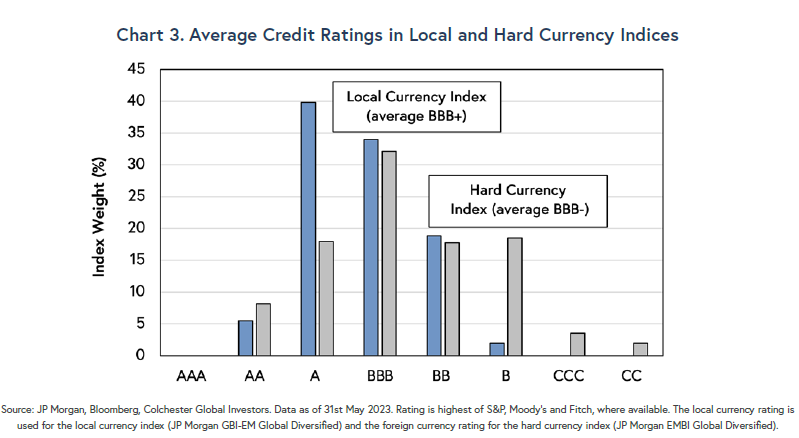
This difference in financial stability and credit quality in part may explain the shift observed in relative volatility between the two categories of EM debt in recent years. Historically the hard currency asset class has exhibited lower volatility than the local currency asset class (unhedged in US dollars). This is evident in Chart 4. However, as shown in Table 1, returns and the volatility of the two asset classes has essentially been the same over the past three years to the end of May 2023. As demonstrated in Chart 4, the rolling three-year volatility of the hard currency index jumped higher at the start of the Covid-19 pandemic and has remained at elevated levels since. In contrast, whilst the volatility of the local currency index also moved higher in response to the Covid shock, it did so to a notably lesser degree. While the local currency component of returns has historically been more volatile and the dominant driver of the volatility of the asset class, it was relatively muted in response to the Covid shock, hinting at greater maturity and increased stability within the asset class.
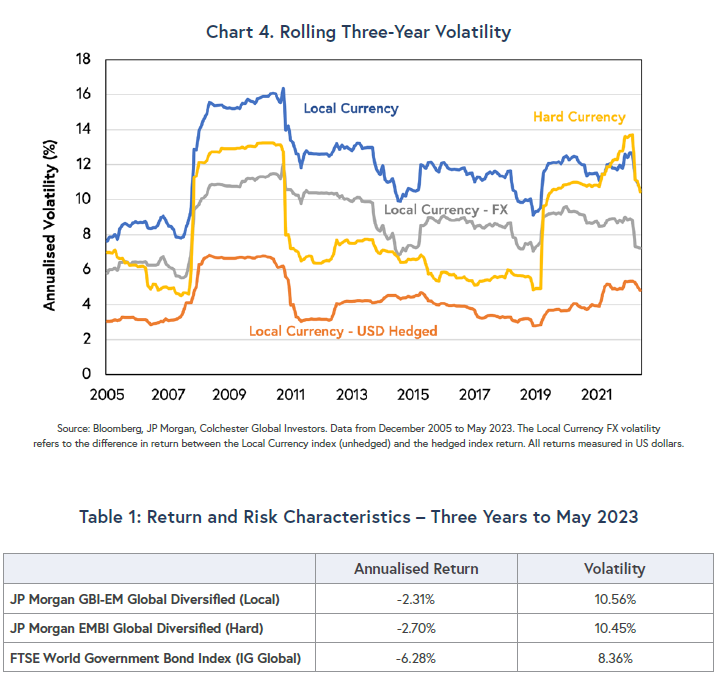
As the returns of hard currency EM debt are primarily driven by (i) the direction of the US Treasury market, (ii) individual country risk characteristics or credit premiums, and (iii) the direction of the US dollar (for non-US dollar investors) , this leads to different correlation characteristics compared with returns on local currency debt. Hard currency EM sovereign debt is typically held by global investors and is priced by the market in terms of the spread to a benchmark yield curve such as US Treasuries in the case of US dollar denominated debt. Accordingly, EM Dollar debt is priced in a similar manner to USDdenominated corporate bonds. A rise in Treasury yields typically prompts a rise in yields of those bonds priced relative to them, and vice versa.
In contrast, local currency debt is usually held predominately by local investors (although foreign investors are also involved). Furthermore, local currency debt returns are driven more by the local factors driving each country’s domestic yield curve and are therefore somewhat less sensitive to changes in global financial conditions (although clearly not immune). Foreign investor returns in local currency debt are also impacted by the direction of the currency. Accordingly, Thai bond returns can, and do, diverge from those in South Africa or Colombia, as each market is underpinned by their own domestic inflation outlook, macroeconomic backdrop, etc., not necessarily by what is going on in the US Treasury market. Within an aggregate multi-asset portfolio, this is likely, on average, over time, to lead to local currency debt potentially offering better diversification characteristics compared with its hard currency counterparty as each country’s bond market is responding to its own particular set of conditions.
Not surprisingly, given the higher weight in lower rated credits in the hard currency Index, it is highly correlated with High Yield corporate debt. The correlation between the JP Morgan EMBI Global Diversified and the BoA Merrill Lynch US High Yield index over the past 5 years has been 0.86, whereas the correlation between the Local Currency index and High Yield over the same period was 0.71. Whilst the local currency correlation is still on the high side, the absolute level of this positive correlation is not surprising given the events of the past 5 years. All so-called “risk assets” declined in response to the twin shocks of the Covid pandemic and the invasion of Ukraine, and together with all fixed income assets subsequently suffered to various degrees in response to the global back up in yields over the past 18 months, or so. Nonetheless, we believe that the domestic drivers of local market returns are likely to dominate over time, pointing towards a somewhat lower correlation of the local currency asset class with High Yield, and potentially better diversification.
Headwinds for EM Debt turning to Tailwinds…
We have identified two powerful drivers of EM debt returns which we believe are now clearly pointing to strong returns over the medium term on this asset class; 1) The cycle in US dollar exchange rate, and 2) the inflation environment in EM and associated level of real yield on offer in Local Currency EM.
The US Dollar Cycle
Historically the direction of the US dollar has been closely linked with the performance of EM assets. When the USD strengthens, this often coincides with a tightening of global financial conditions putting pressure on those emerging economies with weaker balance sheets, running current account deficits, or dependent upon foreign capital. It also typically leads to currency weakness amongst the EM currencies, placing upward pressure on EM inflation, and prompting a deterioration in credit quality. This mechanism also plays out in the DM world to various degrees.
The past two decades have seen two distinct cycles of the US dollar, (i) the depreciation in the first seven to eight years of this century, and (ii) the major appreciation that took place from 2011 to 2022 (even though this extended upward trend of the Dollar did see periods of weakness in 2017 and 2020). The Dollar also went through a period of consolidation over 2008-2011. These three periods can be seen in Chart 5.
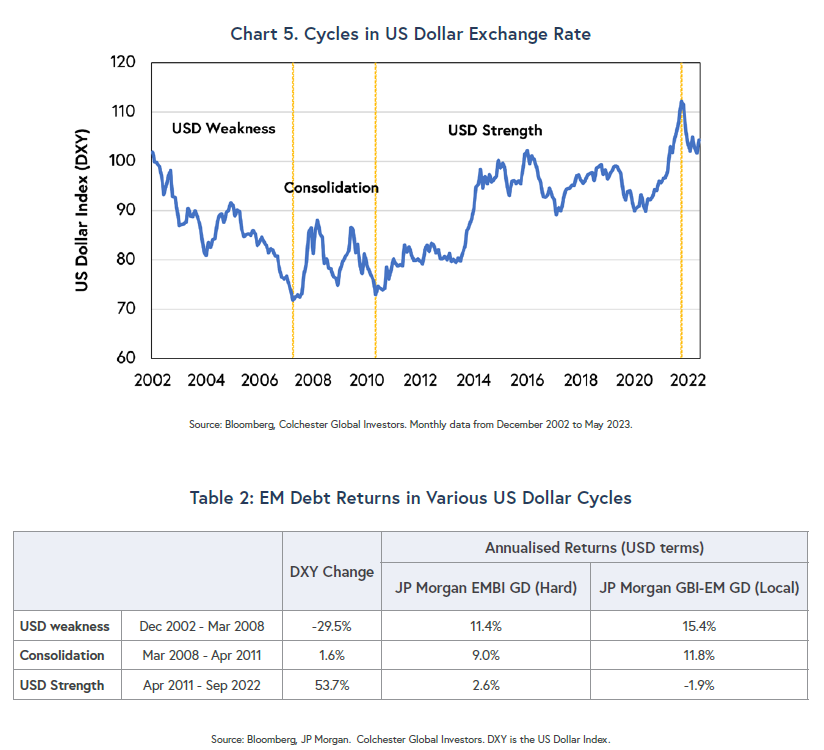
Looking at the respective US dollar returns of the local and hard currency EM bond classes over these periods, unsurprisingly it is readily apparent that they are highly correlated with the direction of the Dollar (Table 2). The hard currency index outperformed relative to the local index when the Dollar strengthened and underperformed when it weakened. Local also outperformed during the “sideways” or consolidation period as the currency impact became moot and, in all likelihood, the higher nominal and real interest rates on offer in the local bond space dominated. This assessment is reinforced when we look at the correlation of local currency returns with the direction of the Dollar in Chart 6, and the relationship of relative performance between hard and local debt, and the dollar in Chart 7. Whilst not the only factor driving returns, local EM debt has historically outperformed in both absolute and relative terms in a falling Dollar environment, and hard currency EM debt has done better when the Dollar has appreciated. So where are we today?
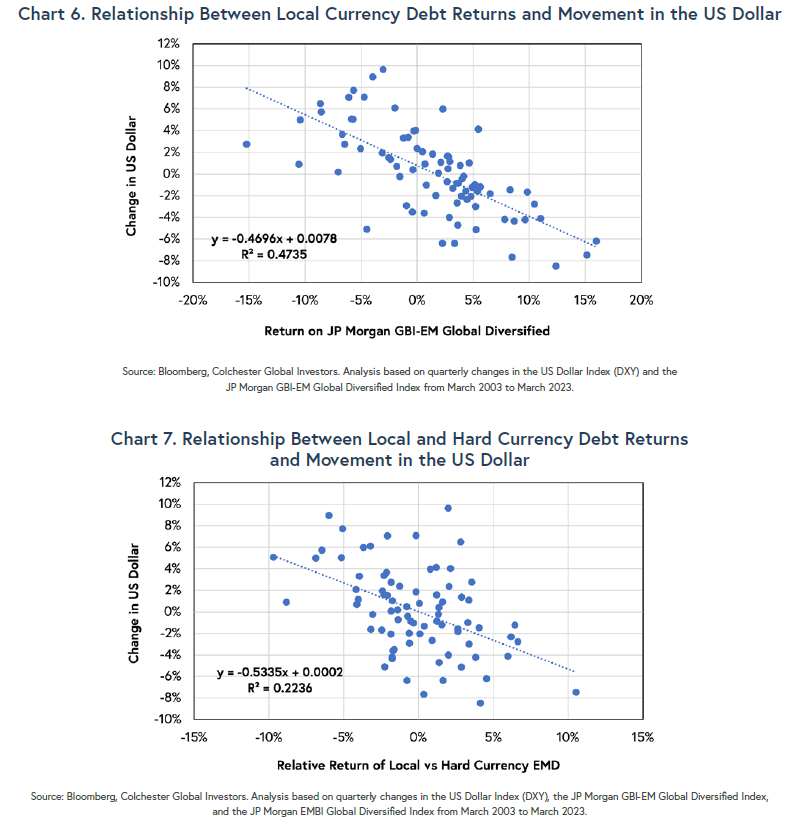
As the cornerstone of our currency valuation framework, we believe that the real exchange rate provides a useful metric with which to assess the relative value of currencies over the medium term. Our current assessment of the real value of the US dollar suggests that it may have peaked towards the end of 2022 and may be at the beginning of another cycle of USD depreciation, similar to that seen in the 2000’s. Colchester estimates that the USD reached an overvaluation in real terms of close to 30% against an equally weighted basket of five major developed world currencies(8) in late 2022. A similar level of Dollar overvaluation was also evident against a diversified basket of emerging market currencies. Whilst the Dollar has weakened a bit from its high, our analysis suggests that it remains meaningfully overvalued in real terms in mid-2023. History therefore suggests further Dollar weakness may be expected in the medium to long-term.
Turning points are notoriously difficult to identify ex-ante in all financial markets, and maybe even more so in currency markets. Nonetheless, as well as the extreme real exchange rate overvaluation, there are some other indications that we may have seen the peak in the US dollar for this cycle. For one thing, the aggressive tightening of the US Federal Reserve relative to other countries was widely believed to have contributed to USD appreciation last year(9). Today, contracting money supply in the US suggests that the inflation outlook may improve rapidly in the US. The stock of money in the US economy, as measured by M2, peaked in mid-2022 and has been declining since, with the latest annual change running at -4.6%, the lowest rate of change since the Great Depression. This suggests that the end of the rate hiking cycle may be approaching, potentially removing this perceived relative interest rate support for the Dollar. The other support for the US dollar in 2022 was the positive change in the US economy’s terms of trade, relative to economies in Asia and Europe. Here too, given the declines in commodity and energy prices in the first half of 2023, this supportive backdrop may also be reversing.
Inflation and Real Yields in EM
As noted above, the inflation experience of many of the major Emerging Markets over the past 18 months has not been dissimilar to that of Developed Markets. There was certainly a surge in inflation across Latin America and Central Europe in response to the post-pandemic supply chain disruptions, aggressive stimulus, and elevated food and energy prices. The experience in Asia was more mixed, but nonetheless, upward pressure on inflation did materialise in certain economies. Notably, however, as global inflation pressures have receded, inflation has declined in Emerging Markets at a similar if not, faster pace, than seen in some Developed Markets. Particularly in Latin America, inflation has been on a clear downward trajectory after peaking in 2022 in economies such as Brazil, Mexico, and Chile.
This disinflationary process underway in many of the major Emerging Markets is hardly surprising given the pace and scale of monetary policy tightening undertaken. Not only were many EM Central Banks more conservative than their DM counterparts in response to the Covid shock, they were also much more aggressive in tightening policy in the face of the deteriorating inflation outlook. In Brazil and Mexico for example, the respective central banks commenced rate increases some 12 months before the US Federal Reserve (see Chart 8). Nominal policy rates are now in double-digit territory in both economies, resulting in high real policy rates, underpinning the disinflationary process, and raising the likelihood that rates may be cut later in the year. Irrespective of the timing of any potential monetary policy adjustment in these countries, and elsewhere, the high nominal interest rates on offer combined with the improving inflation outlook is presenting very high prospective real yields in many of the EM local currency bond markets. This makes those markets attractive in both absolute and relative terms compared to their developed world counterparties, including the US.
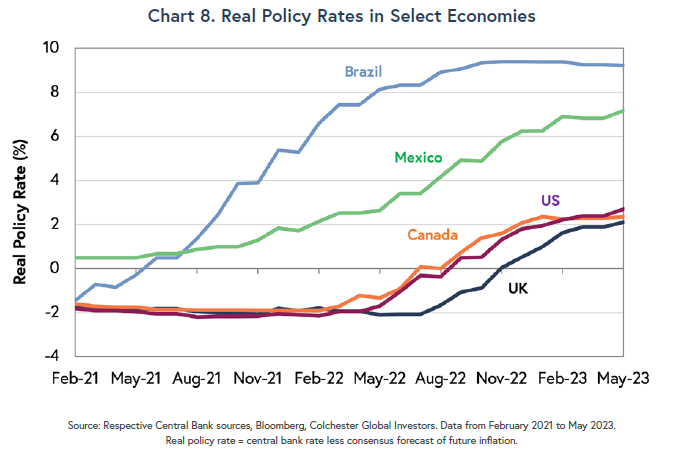
Assessment of Potential Real Value on Offer in EM Local Currency Debt
Colchester’s prospective real yield, and real exchange rate valuation approach provides a framework within which potential medium term local currency debt returns may be assessed. Both benchmark and Colchester program bond and currency exposures can be converted into a potential real return by multiplying their respective weights by the prospective real yield and real exchange rate(10) on offer in each market. This provides a metric that can be assessed through time.
Chart 9 suggests that the current “value” on offer in both the JP Morgan GBI-EM Global Diversified Index and in the Colchester local currency programme is close to historical highs. The attractive prospective real yields on offer in the opportunity set combined with the undervaluation of emerging market currencies versus the US dollar make a compelling valuation case relative to history. The positive inflation outlook in conjunction with high nominal yields on offer in many EM markets suggests a prospective real yield bond return approaching 3% on the benchmark, and something closer to 4% on the Colchester program. Similarly, the sustained real exchange rate undervaluation of EM currencies versus the US dollar of some 15% on the benchmark, and approximately 20% on the Colchester currency exposures, suggests another 3% and 4% respectively of intrinsic value on offer on the currency side. Combining both suggests a potential real return of around 6% on the benchmark and some 8% on the Colchester program. As Chart 9 highlights, both compare favourably with an average of some 3% and around 5% respectively since inception of the Colchester program in January 2009.
Relative to its history, this metric suggests the local currency debt asset class is currently offering attractive value.
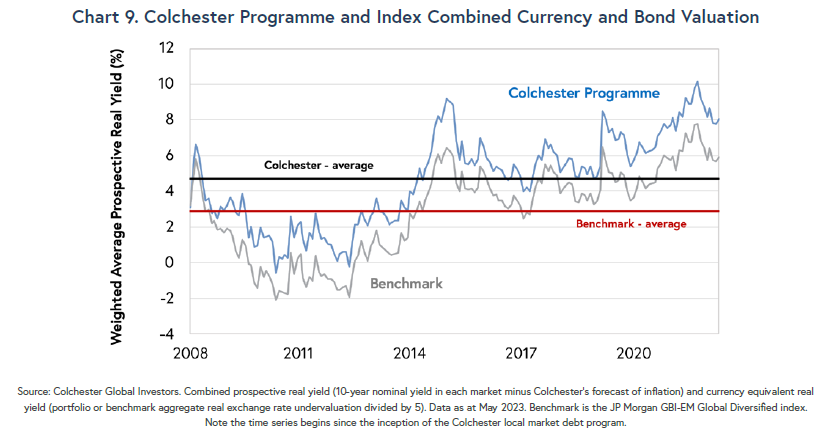
Conclusion
Compelling prospective real yields, the potential for further declines in inflation, improved macroeconomic stability across much of the EM local currency debt space, and meaningful real currency undervaluation versus the US dollar all provide a positive backdrop for the asset class going forward. Local currency EM debt is likely to prosper in this environment and may be expected to outperform its hard currency EM debt counterpart should the US dollar continue to fall. History suggests local currency debt outperforms hard currency debt during periods of US dollar weakness. Against its own history, Colchester’s assessment of the potential real return on offer in the local currency debt space is particularly attractive at this juncture.
1 The most commonly referenced benchmark index for local currency emerging market debt – the JP Morgan GBI-EM Global Diversified Index – was incepted in 2003.
2 The IMF estimate Advanced Economy average gross government debt at 112% of GDP. Source IMF, WEO, April 2023.
3 Published CPI data for May 2023.
4 The majority of EM hard currency debt is issued in US dollars, with a smaller proportion issued in Euro. Some residual British pound debt also remains in issue.
5 The Gulf States are members of the Gulf Cooperation Council (GCC) and include Saudi Arabia, the UAE, Kuwait, Bahrain, Qatar, and Oman. They comprise just under 14% of the hard currency index, encompassing all of the AA and half of the A countries shown in Chart 3. As these countries operate fixed exchange rate regimes that are pegged to the US dollar, they are natural issuers of US dollar debt.
6 Source: 2022 Annual Sovereign Default and Rating Transition Study, S&P.
7 As noted in footnote 4, most EM hard currency debt is issued in US dollars, hence the focus on the underlying US treasury bond market and US dollar.
8 The Euro, British pound, Japanese yen, Canadian dollar, and Norwegian krone.
9 See “Global Exchange Rate Adjustments: Drivers, Impacts and Policy Implications”, BIS, Nov 2022.
10 Assuming an average 5 year mean reversion process of the real exchange rate to fair value.
Important Information
![]()
Risk Disclosures
• Colchester Global Investors (“Colchester”) does not deem this document to be a marketing communication. This material has been prepared exclusively for use with professional or institutional investors and is not suitable for retail investors. Prospective investors and clients should be aware that any investment involves a degree of risk. Investors should seek professional advice before making an investment. Past performance is no guarantee of future performance and the value of any investment may fall as well as rise. Investment in the products mentioned in this document puts your capital at risk, and you may lose some or all of your investment. No part of this document may be reproduced or published in any form or by any means without Colchester’s prior written permission.
• Unless otherwise stated, this document reflects Colchester’s views and opinions as of 30 June 2023. In respect of the products and strategies mentioned in this document, the information is provided for illustrative purposes only and is intended only for professional clients and third-party intermediaries. Opinions expressed in this document may be changed without notice at any time after publication. Notwithstanding our fiduciary duties to existing clients, Colchester makes no representation or warranty as to the accuracy or completeness of the information in this document and disclaims all liability for any direct, indirect, consequential or other losses or damages including loss of profits incurred by you or any third party that may arise from reliance on this document.
• Unless shown otherwise, all returns are illustrated as gross of fees. Gross returns do not reflect the deduction of fees and expenses, which would inevitably reduce the client’s returns. Additional information regarding policies and procedures for calculating and reporting returns is also available on request. Nothing in this document should be construed as providing any type of investment, tax or other advice, or be considered a solicitation, recommendation, endorsement or offer to purchase or sell any financial instrument.
• There is no guarantee that the investment approach, techniques, or strategies utilised by Colchester will be successful or profitable. There can be no assurance that the specific trading strategies utilised will produce profitable results. Any factor that would make it difficult to execute trades, such as reduced liquidity or extreme market developments could have an adverse effect on performance. Investing in frontier markets involves a greater risk of loss than investing in more developed markets due to, among other factors, greater illiquidity, regulatory, political, tax and economic risks.
• Responsible investing is an integral part of the investment process, however Colchester never makes investment decisions based solely upon Environmental Social Governance (ESG) factors. Unless specified in the client Investment Management Agreement or offering documents, specific assets with poor ESG ratings may not be excluded from portfolios. Client strategies which invest on the basis of sustainability/ ESG criteria involves qualitative and subjective analysis. There is no guarantee that the determinations made by Colchester will be successful and/or align with the principles of specific investors.
• Prospective investors and clients should be aware that any investment involves a degree of risk. The return of your investment may increase or decrease as a result of currency fluctuations if your investment is made in a currency other than that used in the past performance calculation within this document.
• Where foreign securities are included in a portfolio there may be potential constraints on liquidity and the repatriation of funds, macroeconomic risks, political risks, foreign exchange risks, tax risks, settlement risks; and potential limitations on the availability of market information. Clients and potential investors acknowledge the inherent risk associated with the selected investments and that there are no guarantees.
• This is not a research report and is not intended as such. Certain information in this document may constitute forwardlooking statements. Due to the various uncertainties and actual events, the actual performance of the markets may differ materially from those reflected or contemplated in such forward-looking statements. As a result, clients/ investors should not rely on such forward-looking statements in making any investment decisions.
• This document may contain information obtained from third parties, including ratings from credit ratings agencies. Reproduction and distribution of third party content in any form is prohibited, except with the prior written permission of the related third party. Third party content providers do not endorse or recommend the securities or products discussed herein, nor do they guarantee the accuracy, completeness, timeliness or availability of any information, including ratings (negligent or otherwise), regardless of the cause, or for the results obtained from the use of such content. Third party content providers give no express or implied warranties, including, but not limited to, any warranties of merchantability or fitness for a particular purpose or use. Third party content providers shall not be liable for any direct, indirect, incidental, exemplary, compensatory, punitive, special or consequential damages, costs, expenses, legal fees, or losses (including lost income or profits and opportunity costs or losses caused by negligence) in connection with any use of their content, including ratings. Credit ratings are statements of opinions and are not statements of fact or recommendations to purchase, hold or sell securities. They do not address the suitability of securities for investment purposes and should not be relied on as investment advice.
• All securities are rated by Nationally Recognized Statistical Rating Organizations (NRSRO) Moody’s, Standard & Poor’s (S&P), and/or Fitch. If a security is rated by more than one of these organisations, the highest rating assigned is used in our credit rating breakdowns. Ratings are measured on a scale that generally ranges from AAA (being the highest) to D (being the lowest).
• Information concerning the calculation of statistics used for portfolio characteristics is available upon request. Various industry standards, indices and industry performance comparative data are provided in this document and are detailed where appropriate. These include indices from FTSE, Bloomberg, MSCI, JP Morgan and ICE. Data is sourced additionally from Bloomberg and Datastream.
• London Stock Exchange Group plc and its group undertakings (collectively, the “LSE Group”). ©LSE Group 2023. FTSE Russell is a trading name of certain of the LSE Group companies. FTSE® is a trade mark of the relevant LSE Group companies and is used by any other LSE Group company under license. “TMX®” is a trade mark of TSX, Inc. and used by the LSE Group under license. All rights in the FTSE Russell indexes or data vest in the relevant LSE Group company which owns the index or the data. Neither LSE Group nor its licensors accept any liability for any errors or omissions in the indexes or data and no party may rely on any indexes or data contained in this communication. No further distribution of data from the LSE Group is permitted without the relevant LSE Group company’s express written consent. The LSE Group does not promote, sponsor or endorse the content of this communication.
• Bloomberg Index Services Limited. BLOOMBERG® is a trademark and service mark of Bloomberg Finance L.P. and its affiliates (collectively “Bloomberg”). Bloomberg or Bloomberg’s licensors own all proprietary rights in the Bloomberg Indices. Neither Bloomberg nor Bloomberg’s licensors approves or endorses this material, or guarantees the accuracy or completeness of any information herein, or makes any warranty, express or implied, as to the results to be obtained therefrom and, to the maximum extent allowed by law, neither shall have any liability or responsibility for injury or damages arising in connection therewith.
• Information has been obtained from sources believed to be reliable but J.P. Morgan does not warrant its completeness or accuracy. The Index is used with permission. The Index may not be copied, used, or distributed without J.P. Morgan’s prior written approval. Copyright 2023, J.P. Morgan Chase & Co. All rights reserved.
• There can be no assurance that professionals currently employed by Colchester will continue to be employed by the firm or that a level of experience or past performance is indicative of future performance or success. • Information about how to make a complaint, any right to compensation and any cancellation rights will be provided to you upon request.
Regulatory Information
• Colchester is an employee-owned firm headquartered in London and has regional offices in New York, Singapore, Dublin and Dubai with a representative office in Sydney, Australia.
• Colchester is authorised and regulated by the Financial Conduct Authority in the United Kingdom. Colchester is also registered with the Securities and Exchange Commission in the USA.
• Colchester Global Investors Limited is licensed as a financial services provider by the Financial Sector Conduct Authority (licence number 43012) in South Africa.
• Colchester Global Investors Limited is registered with the Securities Commission of The Bahamas, as the investment manager for an investment fund licensed as a Smart Fund model 003, in accordance with the provisions of the Investment Funds Act, 2019.
• Colchester Global Investors (Singapore) Pte. Ltd holds a capital markets services licence in fund management issued by the Monetary Authority of Singapore. Colchester Global Investors (Singapore) Pte. Ltd also holds an offshore discretionary investment management services licence issued by the Financial Services Commission of Korea.
• Please note the following in respect of Colchester’s regulatory status in Australia: (i) neither Colchester Global Investors Limited nor Colchester Global Investors (Singapore) Pte. Ltd. holds an Australian financial services licence for the provision of certain financial services, and both entities are exempt from the requirement to hold an Australian financial services licence under the Corporations Act 2001 (Cwlth) in respect of the financial services Colchester provides; (ii) Colchester Global Investors Limited is authorised and regulated by the Financial Conduct Authority of the United Kingdom under UK laws, which differ from Australian laws; (iii) Colchester Global Investors (Singapore) Pte. Ltd. is regulated by the Monetary Authority of Singapore under Singapore laws, which differ from Australian laws. Therefore, Australian wholesale clients are not necessarily subject to the same types of legal protections or remedies that they would enjoy if Colchester was directly subject to the Corporations Act. Colchester is entitled to offer its financial services in Australia pursuant to an exemption from the requirement to hold an Australian Financial Services Licence under the Corporations Act, on the basis, among other things, that the clients are “wholesale clients” within the meaning of the Corporations Act.
• Colchester Global Investors Middle East Limited is regulated by the Dubai Financial Services Authority for the provision of Advising on Financial Products and Arranging Deals in Investments. All communications and services are directed at Professional Clients only. Persons other than Professional Clients, such as Retail Clients, are not the intended recipients of Colchester Global Investors Middle East Limited’s communications or services. Colchester Global Investors Middle East Limited is a company established in the Dubai International Financial Centre (DIFC) pursuant to the DIFC Companies Law with registration number CL 3239.
• Colchester Global Investors Inc. is a wholly owned subsidiary of Colchester Global Investors Limited. It is not permitted to provide investment advice or otherwise engage in a regulated activity.
• Colchester Global Investors (Dublin) Management Limited is authorised and regulated by the Central Bank of Ireland in Ireland. Colchester Global Investors (Dublin) Management Limited is registered in Ireland, Company Registration No: 683693.
THIS DOCUMENT IS INTENDED FOR PROFESSIONAL USE ONLY AND IS NOT FOR PUBLIC DISTRIBUTION. IT MAY CONTAIN
INFORMATION THAT IS PRIVILEGED, CONFIDENTIAL OR EXEMPT FROM DISCLOSURE UNDER APPLICABLE LAW. IF YOU
HAVE RECEIVED THIS COMMUNICATION IN ERROR, PLEASE DISREGARD AND DELETE IT AND DO NOT DISSEMINATE THE
CONTENTS TO ANY OTHER PERSON.
THIS DOCUMENT DOES NOT CONSTITUTE A PROSPECTUS OR OFFERING CIRCULAR TO SUBSCRIBE FOR ANY SECURITIES.
POTENTIAL INVESTORS MUST REVIEW THE RELEVANT PRODUCT OFFERING DOCUMENTS OR INVESTMENT MANAGEMENT
AGREEMENT, AND IN PARTICULAR, THE RISK DISCLOSURES SET OUT THEREIN.

